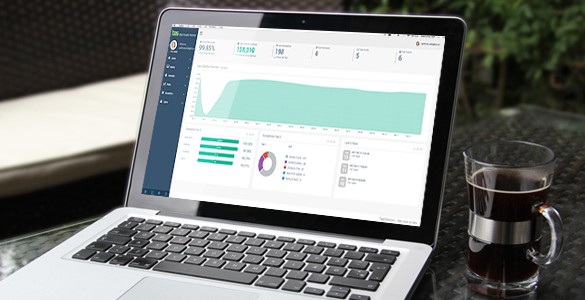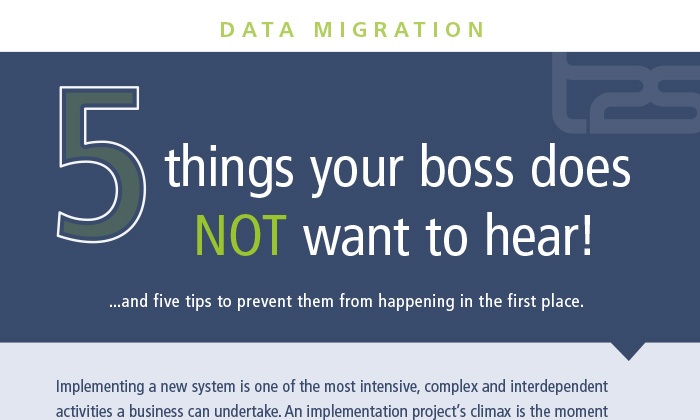Moving onward to a new system?
Your new solution needs to fuse your ongoing data flow with your historical data. But that data is stuck in your legacy system. You face the challenge of finding and extracting your old data, and migrate what matters into the new solution. The data has to be checked for quality and fitness to ensure it conforms to your new setup. Only then can your operations rely on the new solution.
Data migration and data integration
Make your data migration a success with T2S’ distinctive combination of technical know-how, business experience, data experts and solutions.
Read more about our approach and experience with data migration and integration. Scroll down for our checklist with 5 tips for a successful data migration.
- Migrate your data with minimal risk and no delays
- Proven strategies and tools for retrieving, transporting and validating data
- T2S Data Migration Platform and Data Quality Dashboard
- Agile approach in order to be able to respond quickly to changes
- Extensive data migration and integration experience
- Large-scale business critical data migrations - done right and on time
Proven data migration approach
Type 2 Solutions uses a standard data migration approach for retrieving, transforming, validating and loading data. This approach consists of the following steps:
1. Data migration plan
We start with a preliminary study of the data migration with a data migration plan as deliverable. This plan includes: the data migration strategy, the action plan, a risk analysis, the data migration process, the control framework, the data quality optimization process, the planning and the required resources and tools.
2. Carrying out the data migration
The data migration is carried out according to the established data migration plan:
- We start with the target system (or the target systems).
- Within the target system, we identify the data sets (business objects) within the scope of the data migration. Examples of data collections are customers or relations, contracts and prices.
- We make a migration model per data collection. This is a contract in which the agreements regarding the data are recorded.
- Based on the migration model, we perform an analysis of the source system (or the source systems).
- Then we extract the data from the source system.
- The data is loaded into the T2S Migration Platform.
- The platform handles transformation and validation of the data.
- All exceptions that hinder a successful data migration are presented in the T2S Data Quality Dashboard.
- If all data is correct, it will be loaded into the target system.
Iterative process
A data migration is an iterative process. We use an agile approach in order to be able to respond quickly to changes. Validating the entire process and the associated data is a joint responsibility of you, us and the supplier of the new system.
After various test migrations, extensive testing and after approval by the steering group based on the predefined acceptance criteria (control framework), the final data migration takes place.
Importance of test runs
John Wittekamp, Chief Technology Officer at DELTA Fiber Netherlands emphasizes the importance of test runs during a migration:
“The role of Type 2 Solutions is focused on the quality of the data transfer and is therefore an important part of the team to ensure that you as a whole make the right choices to transfer that data correctly. In particular, performing another test run was typically something that was very much stimulated by Type 2 to ensure that you also achieve the best quality you can deliver.”
T2S helped DELTA Fiber Netherlands with the data migration to the new IT systems by deploying data specialists alongside the data migration platform & data quality dashboard within the organization on a project basis.
Video – Interview with John Wittekamp CTO DELTA Fiber Netherlands.
Data migration plan
Drawing up a data migration plan takes 10 working days on average. First, there will be a preliminary investigation of the data migration which looks into the source and target system.
Scope of the migration
You always need to start with the target system. Within the target system, you identify the data sets (business objects) that are within the scope of the data migration. An example of a data set is clients or relations, contracts and prices.
Form and content of the migration
The target system determines the form and content of the data migration. To give an example: in the new system, you redefine the ‘business client’ and ‘private client’.
In the present system, a business client is a company. In the new system, you call a business client ‘any entity that purchases business products from us’. In that case, you have changed the definition, which impacts the way that you migrate the data.
Benefits of a data migration plan
Why would you start with a preliminary investigation with a data migration plan as your deliverable?
The answer is very simple: because you need to know, as does any organisation, what it will cost, who you need to hire, how long it will take, and what the risks are.
For the execution of a data migration plan you need to pick an expert. It should be someone who has extensive experience with data migrations and excellent knowledge of data analysis and database platforms.
Migrating data is a specialism whereby the quality of the data is crucially important. Find the right people and arrange for a (control) framework.
Less is more!
With the proper tools, one expert can accomplish more and achieve better results than five generalists.
Data migration and data quality
Based on the target system(s) and the wishes and requirements of the business, the data analysis and data discovery of the source systems starts.
The data is reviewed on quality; correctness, completeness and comprehensiveness. The data quality is then displayed in a clear online dashboard: the Data Quality Dashboard.
Which checks must be performed is evaluated for each data set (business object). They depend on the importance of the data collection and the degree of certainty that must be obtained.
External source systems can be used to enrich the data.
Data migration at Eichholtz
Jeroen Raijmakers, IT Director at Eichholtz, shares:
“Type 2 Solutions provided us guidance in the project. The system Type 2 Solutions uses, the Data Migration Platform in combination with the Data Quality Monitor, works like a charm. We continuously had a reference point available during the migration process; this has been migrated, this had been uploaded and these are the differences. The customer data was migrated smoothly, due to the preparation we had with the data quality project.”
T2S helped Eichholtz with the data migration to the new IT system by deploying a data specialist alongside the data migration platform & data quality dashboard within the organization on a project basis.
Video – Interview with Jeroen Raijmakers IT Director Eichholtz.
Extensive experience
We have 20 years of experience with data migration and data integration. In addition to extensive experience with various database platforms, such as Oracle, Microsoft SQL Server, IBM DB2 and MySQL, T2S has experience in migrating data to and integrating data between various IT systems and software packages.
Our data specialists have experience with data migration, integration and data quality projects in various fields such as aviation, finance, food, chemicals, logistics, healthcare, government, IT, mobility, energy, telecom and multimedia.
T2S has experience with data migrations of and data integration with the following IT systems, software packages and database platforms:
- SAP
- Dynamics 365 Business Central (MS Dynamics NAV / AX)
- Mainframe AS400
- UMAX 365 (MS Dynamics 365)
- AFAS
- Exact Globe
- Progress (QAD)
- Aptic
- Oracle Utilities Customer Care and Billing
- MaxBill
- Exact online
- GEA Toll system
- Transaction Information and Processing System (Toll system TIPS)
- Carmen Crew Management System (Jeppesen)
- ORTEC Workforce Scheduling (Harmony)
- Magento eCommerce platform
- Selligent marketing platform
- Fusion Equation (Finastra – Banking operations)
- SafeWatch (EastNets)
- SAP CRM
- Dynamics CRM
- Salesforce
- Care4 ECD/EPD
- User ECD/EPD
- mijnQuarant EPD
- SAP BO
- Microsoft Azure
- Informatica
- Power BI
- SSIS (SQL Server Integration Services)
- SSRS (SQL Server Reporting Services)
- IBM DB2
- Oracle on Linux
- Oracle on AIX
- Microsoft SQL Server
- Informix
- Sybase
- PostgreSQL
- MySQL
Client testimonials
Read more about what our customers have to say about working with T2S.
“ Type 2 Solutions has handled the data migration to our fullest satisfaction. Their approach has been utterly professional and thoroughly organized. Another important fact is that they really got into our business processes. ”
“ Type 2 Solutions has helped us conduct the migration with great professionalism and helped shape it through specialized focus. In particular in relation to the move of data from the old to the new systems, the area which is crucial to get right. That is the core of your business. ”
Checklist Data Migration
Five things your boss does not want to hear
We have collected 5 statements that are heard at some point in any given migration project, whether from the project team or from the business itself. For each of them, we have put together a number of tips to prevent them. And hopefully, they will help you, so you never again need to say:
 We’re running out of budget!
We’re running out of budget!
 We’re running out of time!
We’re running out of time!
 We’re running out of resources!
We’re running out of resources!
 The new system is not working!
The new system is not working!
 We can’t go live!
We can’t go live!
T2S data migration solutions
Migration Platform
The transport of your data is done with our T2S Migration Platform. A software platform that can access, transform and validate data from the most diverse IT systems and process it into a format that can be imported into another IT system. If your operations have to keep going 24/7, the platform can help with running the legacy system in parallel with your new solution.
Data Quality Dashboard
Data integration and conversion projects often face unanticipated data quality challenges. The T2S Data Quality Dashboard helps you to tackle data quality issues. It provides that kind of insight that makes it possible to improve and maintain data quality.
Let’s talk data business
Feel free to contact us to discover the possibilities for your company. Please leave your details and we will contact you as soon as possible.

Frequently asked questions about data migration
Data migration is the process of moving data. It is the transfer of information from your present IT system or systems to a new IT system or systems.
Data migration means that you transfer data from A to B, whereas in data integration, the data stays in A, but is integrated in a process. The data is exchanged with another system.
A data migration consists of Extraction, Transformation, validation and Loading of data (ETL). From preparing the data of the present system (extraction) to transformation (conversion) and validation (data quality) of the data to offering data to the new system (loading).
After you have decided that it is time to put a new system in place. Start thinking about the data migration before you choose the new system.
Data migration factors into your choice for a new system and supplier. Compare it to moving house. If you are unsure as to whether the furniture that you care about is going to fit in the new home easily or only by pulling out all the stops, this will affect your choice for a new home.
Your requirements for the new system are that you can migrate data into it, that it supports your operational processes and that you can bring the data that is now available to you to the new system or systems. In addition, you will want to know which data migration tasks will be the supplier’s responsibility and which tasks you will be expected to take on during the implementation.
When a programme manager is set to implement a new system, they will want to know beforehand how much effort it will take to run tests and train users, and how long it will take to migrate the data. Say you want the migration to be completed within one weekend, but the loading of all the data is going to take 6 weeks. It is clear that this is not feasible. In brief, you will need to give this some thought beforehand, so the data migration will form an integral part of the programme and you can make a budget available for this purpose.
Data migration is important because your new solution needs to fuse your ongoing data flow with your historical data. You face the challenge of finding and extracting your old data. The data must be checked for quality and fitness to ensure it conforms to your new setup. Only then can your operations rely on the new solution.





